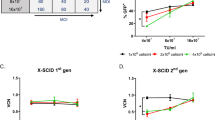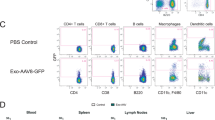Abstract
Lentiviral vectors represent an attractive technology platform from which to develop a targetable injectable gene delivery system for transduction of specific cell populations in vivo, irrespective of their cell cycle status. Targeted HIV-1-based lentiviral vectors were generated by pseudotyping them with chimeric murine leukemia virus (MLV) envelope glycoproteins displaying N-terminal targeting polypeptides. Vectors displaying an EGF polypeptide were fully infectious on EGF receptor-negative cells, but were inactive on cells with abundant EGF receptors (inverse targeting). Receptor-mediated inactivation of gene transfer was overcome by competing the EGF receptors on the target cells with soluble EGF or by removing the displayed EGF domain from the surface of the vector particles by factor Xa cleavage of a specific protease substrate engineered into its tethering linker (protease targeting). Intravenous infusion of nontargeted HIV-1 vectors led to maximal luciferase activity in liver and spleen with moderate or minimal activity in heart, skeletal muscle, lung, brain, kidney, ovaries and bone marrow. In contrast, intravenous EGF-displaying vectors were expressed maximally in spleen with very low level luciferase expression detectable in liver (EGF-receptor rich). Liver transduction by the EGF-displaying vector was restored by pretreating the animals with soluble EGF suggesting that these vectors are inversely targeted to spleen. Gene Therapy (2001) 8, 1456–1463.
This is a preview of subscription content, access via your institution
Access options
Subscribe to this journal
Receive 12 print issues and online access
$259.00 per year
only $21.58 per issue
Buy this article
- Purchase on Springer Link
- Instant access to full article PDF
Prices may be subject to local taxes which are calculated during checkout





Similar content being viewed by others
References
Roe T, Reynolds TC, Yu G, Brown PO . Integration of murine leukemia virus DNA depends on mitosis EMBO J 1993 12: 2099–2108
Vigna E, Naldini L . Lentiviral vectors: excellent tools for experimental gene transfer and promising candidates for gene therapy J Gene Med 2000 2: 308–316
Trono D . Lentiviral vectors: turning a deadly foe into a therapeutic agent Gene Therapy 2000 7: 20–23
Lewis PF, Emerman M . Passage through mitosis is required for oncoretroviruses but not for the human immunodeficiency virus J Virol 1994 68: 510–516
Naldini L et al. Efficient transfer, integration, and sustained long-term expression of the transgene in adult rat brains injected with a lentiviral vector Proc Natl Acad Sci USA 1996 93: 11382–11388
Blomer U et al. Highly efficient and sustained gene transfer in adult neurons with a lentivirus vector J Virol 1997 71: 6641–6649
Kafri T et al. Sustained expression of genes delivered directly into liver and muscle by lentiviral vectors Nat Genet 1997 17: 314–317
Takahashi M, Miyoshi H, Verma IM, Gage FH . Rescue from photoreceptor degeneration in the rd mouse by human immunodeficiency virus vector-mediated gene transfer J Virol 1999 73: 7812–7816
Park F et al. Efficient lentiviral transduction of liver requires cell cycling in vivo Nat Genet 2000 24: 49–52
Somia NV, Zoppe M, Verma IM . Generation of targeted retroviral vectors by using single-chain variable fragment: an approach to in vivo gene delivery Proc Natl Acad Sci USA 1995 92: 7570–7574
Hall FL et al. Targeting retroviral vectors to vascular lesions by genetic engineering of the MoMLV gp70 envelope protein Hum Gene Ther 1997 8: 183–192
Schnierle BS et al. Pseudotyping of murine leukemia virus with the envelope glycoproteins of HIV generates a retroviral vector with specificity of infection for CD4-expressing cells Proc Natl Acad Sci USA 1997 94: 8640–8645
Endres MJ et al. Targeting of HIV- and SIV-infected cells by CD4-chemokine receptor pseudotypes Science 1997 278: 1462–1464
Ohno K, Meruelo D . Retrovirus vectors displaying the IgG-binding domain of protein A Biochem Mol Med 1997 62: 123–127
Martin F et al. Retroviral vector targeting to melanoma cells by single-chain antibody incorporation in envelope Hum Gene Ther 1998 9: 737–746
Indraccolo S et al. Pseudotyping of Moloney leukemia virus-based retroviral vectors with simian immunodeficiency virus envelope leads to targeted infection of human CD4+ lymphoid cells Gene Therapy 1998 5: 209–217
Kayman SC, Park H, Saxon M, Pinter A . The hypervariable domain of the murine leukemia virus surface protein tolerates large insertions and deletions, enabling development of a retroviral particle display system J Virol 1999 73: 1802–1808
Snitkovsky S et al. A TVA-single-chain antibody fusion protein mediates specific targeting of a subgroup A avian leukosis virus vector to cells expressing a tumor-specific form of epidermal growth factor receptor J Virol 2000 74: 9540–9545
Engelstadter M et al. Targeting human T cells by retroviral vectors displaying antibody domains selected from a phage display library Hum Gene Ther 2000 11: 293–303
Lorimer IA, Lavictoire SJ . Targeting retrovirus to cancer cells expressing a mutant EGF receptor by insertion of a single chain antibody variable domain in the envelope glycoprotein receptor binding lobe J Immunol Meth 2000 237: 147–157
Peng, KW, Russell, SJ . Viral vector targeting Curr Opin Biotech 1999 10: 454–457
Ager S et al. Retroviral display of antibody fragments: interdomain spacing strongly influences vector infectivity Hum Gene Ther 1996 7: 2157–2164
Cosset FL et al. Retroviral retargeting by envelopes expressing an N-terminal binding domain J Virol 1995 69: 6314–6322
Morling FJ, Peng KW, Cosset FL, Russell SJ . Masking of retroviral envelope functions by oligomerising peptide adaptors Virology 1997 234: 51–61
Fielding AK et al. Inverse targeting of retroviral vectors: selective gene transfer in a mixed population of hematopoietic and nonhematopoietic cells Blood 1998 91: 1802–1809
Peng KW et al. A gene delivery system activatable by disease associated matrix metalloproteinases Hum Gene Ther 1997 8: 729–738
Peng KW, Morling FJ, Cosset FL, Russell SJ . Retroviral gene delivery system activatable by plasmin Tumor Target 1998 3: 112–120
Peng KW, Vile R, Cosset FL, Russell SJ . Selective transduction of protease-rich tumors by matrix-metalloproteinase-targeted retroviral vectors Gene Therapy 1999 6: 1552–1557
Hall FL et al. Molecular engineering of matrix-targeted retroviral vectors incorporating a surveillance function inherent in von Willebrand factor Hum Gene Ther 2000 11: 983–993
Gordon EM et al. Systemic adminstration in a matrix-targeted retroviral vector is efficacious for cancer gene therapy in mice Hum Gene Ther 2001 12: 193–204
Jiang A, Dornburg R . In vivo cell type-specific gene delivery with retroviral vectors that display single chain antibodies GeneTherapy 1999 6: 1982–1987
Pham L et al. Concentration of viral vectors by co-precipitation with calcium phosphate J Gene Med 2001 3: 188–194
DePolo NJ et al. VSV-G pseudotyped lentiviral vector particles produced in human cells are inactivated by human serum Mol Ther 2000 2: 218–222
Printz MA et al. Fibroblast growth factor 2-retargeted adenoviral vectors exhibit a modified biolocalization pattern and display reduced toxicity relative to native adenoviral vectors Hum Gene Ther 2000 11: 191–204
Reynolds P, Dmitriev I, Curiel D . Insertion of an RGD motif into the HI loop of adenovirus fiber protein alters the distribution of transgene expression of the systemically administered vector Gene Therapy 1999 6: 1336–1339
Wood M et al. Biodistribution of an adenoviral vector carrying the luciferase reporter gene following intravesical or intravenous administration to a mouse Cancer Gene Ther 1999 6: 367–372
Mateo de Acosta C, Justiz E, Skoog L, Lage A . Biodistribution of radioactive epidermal growth factor in normal and tumor bearing mice Anticancer Res 1989 9: 87–92
Zufferey R et al. Multiply attenuated lentiviral vector achieves efficient gene delivery in vivo Nat Biotechnol 1997 15: 871–875
Zufferey R et al. Self-inactivating lentivirus vector for safe and efficient in vivo gene delivery J Virol 1998 72: 9873–9880
Nilson BH, Morling FJ, Cosset FL, Russell SJ . Targeting of retroviral vectors through protease–substrate interactions GeneTherapy 1996 3: 280–286
Acknowledgements
We thank Dr Tal Kafri for the kind gift of the 293T cells. This work was supported through grants from the Harold W Siebens and George W Eisenberg Foundations and from Cambridge Genetics Ltd, UK.
Author information
Authors and Affiliations
Rights and permissions
About this article
Cite this article
Peng, KW., Pham, L., Ye, H. et al. Organ distribution of gene expression after intravenous infusion of targeted and untargeted lentiviral vectors. Gene Ther 8, 1456–1463 (2001). https://doi.org/10.1038/sj.gt.3301552
Received:
Accepted:
Published:
Issue Date:
DOI: https://doi.org/10.1038/sj.gt.3301552
Keywords
This article is cited by
-
Biodistribution of lentiviral transduced adipose-derived stem cells for “ex-vivo” regional gene therapy for bone repair
Gene Therapy (2023)
-
Gene Therapy for the Nervous System: Challenges and New Strategies
Neurotherapeutics (2014)
-
Optimizing patient derived mesenchymal stem cells as virus carriers for a Phase I clinical trial in ovarian cancer
Journal of Translational Medicine (2013)
-
Tumor-specific imaging through progression elevated gene-3 promoter-driven gene expression
Nature Medicine (2011)
-
Viral vectors: from virology to transgene expression
British Journal of Pharmacology (2009)



